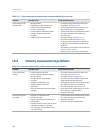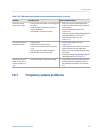
Flow measurement problems and recommended actions (continued)Table 10-3:
Problem Possible causes Recommended actions
Erratic non-zero flow
rate under no-flow
conditions
• Leaking valve or seal
• Slug flow
• Plugged or coated flow tube
• Incorrect sensor orientation
• Wiring problem
• Vibration in pipeline at rate close to sen-
sor tube frequency
• Damping value too low
• Mounting stress on sensor
• Verify that the sensor orientation is appropri-
ate for your application (refer to the sensor
installation manual).
• Check the drive gain and the pickoff voltage.
See Section 10.26 and Section 10.27.
• If the wiring between the sensor and the
transmitter includes a 9-wire segment, verify
that the 9-wire cable shields are correctly
grounded.
• Check the wiring between the sensor and
transmitter. See Section 10.10.
• For sensors with a junction box, check for
moisture in the junction box.
• Purge the flow tubes.
• Check for open or leaking valves or seals.
• Check for sources of vibration.
• Verify damping configuration.
• Verify that the measurement units are con-
figured correctly for your application.
• Check for slug flow. See Section 10.25.
• Check for radio frequency interference. See
Section 10.19.
• Contact Micro Motion.
Erratic non-zero flow
rate when flow is
steady
• Slug flow
• Damping value too low
• Plugged or coated flow tube
• Output wiring problem
• Problem with receiving device
• Wiring problem
• Verify that the sensor orientation is appropri-
ate for your application (refer to the sensor
installation manual).
• Check the drive gain and the pickoff voltage.
See Section 10.26 and Section 10.27.
• If the wiring between the sensor and the
transmitter includes a 9-wire segment, verify
that the 9-wire cable shields are correctly
grounded.
• Check for air entrainment, tube fouling,
flashing, or tube damage.
• Check the wiring between the sensor and
transmitter. See Section 10.10.
• For sensors with a junction box, check for
moisture in the junction box.
• Purge the flow tubes.
• Check for open or leaking valves or seals.
• Check for sources of vibration.
• Verify damping configuration.
• Verify that the measurement units are con-
figured correctly for your application.
• Check for slug flow. See Section 10.25.
• Check for radio frequency interference. See
Section 10.19.
• Contact Micro Motion.
Troubleshooting
Configuration and Use Manual 167


















